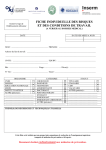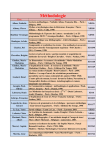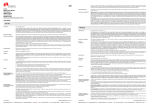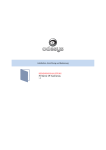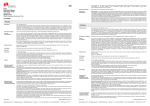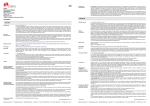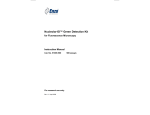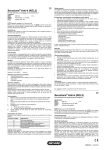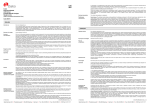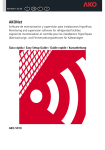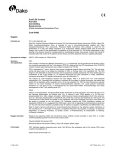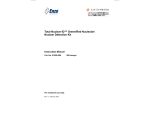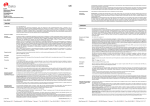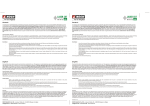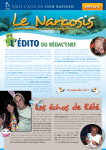Download FLEX Monoclonal Mouse Anti-Human CD246, ALK Protein
Transcript
Verify that the performance of the adjusted protocol is still valid by evaluating that the staining pattern is identical to the staining pattern described in “Performance characteristics”. Counterstaining in hematoxylin is recommended using EnVision FLEX Hematoxylin, (Dako Autostainer/Autostainer Plus) (Code K8018). Non-aqueous, permanent mounting medium is recommended. FLEX Monoclonal Mouse Anti-Human CD246, ALK Protein Clone ALK1 Ready-to-Use (Dako Autostainer/Autostainer Plus) Positive and negative controls should be run simultaneously using the same protocol as the patient specimens. The positive control tissue should include anaplastic large cell lymphoma with t(2;5) translocation and the cells/structures should display reaction patterns as described for this tissue in “Performance characteristics” in all positive specimens. The recommended negative control reagent is FLEX Negative Control, Mouse, (Dako Autostainer/Autostainer Plus) (Code IS750). Staining interpretation Cells labeled by the antibody display cytoplasmic and/or nuclear staining. Performance characteristics Normal tissues: In the nervous system, the antibody labels some glial cells, a few endothelial cells, pericytes and a few scattered neuronal cells. There was no labeling of any cells in hematopoietic and lymphoid tissues, nor of tissues from the gastrointestinal tract and the genito-urinary system (1). Abnormal tissues: A total of 239 cases of lymphoma were analyzed with the antibody. Overall, 53.4% (39/73) cases of CD30+ ALCL were positive. More cases of ALCL in children (23/26 cases = 88.5%) were positive than in adults (16/47 cases = 34.0%). With only a few exceptions, all malignant cells in any positive sample were strongly labeled. Only 1 of 17 cases of “Hodgkin’s-like ALCL” was positive for ALK. All 50 cases of classical Hodgkin lymphoma were unlabelled, as were a wide range of other lymphomas and leukemias analyzed (1). Code IS641 In another study (2), 51% (36/70) cases of ALCL were positive with the antibody, including 15 (42%) T-cell, 16 (44%) null, and 5 (14%) B-cell cases. None of these B-cell cases had the morphology and immunophenotype of the rare large B-cell lymphomas positive for ALK, but negative for CD30, reported by Delsol et al. (5), suggesting that “true” B-cell ALK+ ALCL does exist. In anaplastic large cell lymphoma with t(2;5) translocation, scattered neoplastic cells show a moderate to strong staining reaction. ENGLISH For in vitro diagnostic use. Intended use FLEX Monoclonal Mouse Anti-Human CD246, ALK protein, Clone AKL1, Ready-to-Use (Dako Autostainer/ Autostainer Plus), is intended for use in immunohistochemistry together with Dako Autostainer/Autostainer Plus instruments. This antibody labels normal human ALK protein and the NPM-ALK chimeric protein, and is useful for the identification of the subgroup of anaplastic large cell lymphomas (ALCL) that are ALK positive (1, 2).The clinical interpretation of any staining or its absence should be complemented by morphological studies using proper controls and should be evaluated within the context of the patient's clinical history and other diagnostic tests by a qualified pathologist. Synonym for antigen CD246 (3). Summary and explanation The wild-type anaplastic lymphoma kinase (ALK) protein is a 200 kDa transmembrane receptor tyrosine kinase (4). Postnatal ALK expression is restricted to a few scattered cells in the nervous system (some glial cells and neurons, and a few endothelial cells and pericytes) (1). About 72.5% of ALK-positive ALCL are associated with a (2;5) chromosomal translocation, where the nucleophosmin (NPM) gene located at 5q35 fuses with the ALK gene located at 2p23. With the fusion, the portion of the NPM gene encoding the N-terminal part of the NPM protein is juxtaposed to the part of the ALK gene that codes for the entire cytoplasmic region of the ALK protein. As a consequence, the ALK gene comes under the control of the NPM promoter, which induces a permanent and ubiquitous transcription of the NPM-ALK hybrid gene, resulting in the production of a 80 kDa NPM-ALK chimeric protein (4). In 3 large series of ALCL, 15-28% of chimeric ALK-positive lymphomas were negative for the t(2;5) translocation, and the main alternative fusion gene was identified as the tropomyosin 3 gene representing 17.5% of the ALK-positive ALCL cases (4). FRANÇAIS Pour utilisation lors d’un diagnostic in vitro. Utilisation prévue FLEX Monoclonal Mouse Anti-Human CD246, ALK protein, Clone AKL1, Ready-to-Use (Dako Autostainer/ Autostainer Plus), est destiné à une utilisation en immunohistochimie avec les instruments Dako Autostainer/Autostainer Plus. Cet anticorps marque les protéines ALK et la protéine chimérique NPM-ALK humaines normales et permet l'identification du sous-groupe de lymphomes anaplasiques à grandes cellules (LAGC) positifs à l'ALK (1, 2). L’interprétation clinique de toute coloration ou son absence doit être complétée par des études morphologiques en utilisant des contrôles appropriés et doit être évaluée en fonction des antécédents cliniques du patient et d’autres tests diagnostiques par un pathologiste qualifié. Synonyme de l’antigène CD246 (3). Résumé et explication La protéine kinase (ALK) de type sauvage du lymphome anaplasique est un récepteur tyrosine kinase transmembranaire de 200 kDa (4). L'expression postnatale de l'ALK est limitée à quelques cellules éparpillées dans le système nerveux (certaines cellules gliales et neurones et quelques cellules endothéliales et péricytes) (1). Environ 72,5 % des LAGC positifs à l’ALK sont associés à une translocation chromosomique (2;5), où le gène codant pour la nucléophosmine (NPM) situé en 5q35 fusionne avec le gène ALK situé en 2p23. Lors de cette fusion, la partie du gène NPM codant pour la région terminale N de la protéine NPM est juxtaposée à la partie du gène ALK codant pour toute la région cytoplasmique de la protéine ALK. Par conséquent, le gène ALK passe sous contrôle de l’accélérateur NPM, ce qui provoque une transcription permanente et générale du gène hybride NPM-ALK, et débouche sur la production d’une protéine chimérique NPM-ALK de 80 kDa (4). Refer to Dako’s General Instructions for Immunohistochemical Staining or the detection system instructions of IHC procedures for: 1) Principle of Procedure, 2) Materials Required, Not Supplied, 3) Storage, 4) Specimen Preparation, 5) Staining Procedure, 6) Quality Control, 7) Troubleshooting, 8) Interpretation of Staining, 9) General Limitations. Dans 3 grandes séries de LAGC, 15 à 28 % des lymphomes positifs à l’ALK chimérique étaient négatifs à la translocation t(2;5) et le principal autre gène impliqué dans la fusion était identifié comme le gène tropomyosine 3 représentant 17,5 % des cas de LAGC positifs à l’ALK (4). Ready-to-use monoclonal mouse antibody provided in liquid form in a buffer containing stabilizing protein and 0.015 mol/L sodium azide. Reagent provided Se référer aux Instructions générales de coloration immunohistochimique de Dako ou aux instructions du système de détection relatives aux procédures IHC pour plus d’informations concernant les points suivants : 1) Principe de procédure, 2) Matériels requis mais non fournis, 3) Conservation, 4) Préparation des échantillons, 5) Procédure de coloration, 6) Contrôle qualité, 7) Dépannage, 8) Interprétation de la coloration, 9) Limites générales. Clone: ALK1 (1). Isotype: IgG3, kappa. Immunogen DHFR-ALK recombinant protein comprising mouse dihydrofolate reductase (DHFR) and amino acids 1359-1460 of the full length human ALK protein, corresponding to amino acids 419-520 of the chimeric NPM-ALK protein (1). Specificity Anti-Human CD246, clone ALK1, was clustered as anti-CD246 at the 7th International Workshop and Conference on Human Leucocyte Differentiation Antigens (3). In Western blotting of lysate of the t(2;5)+ SU-DHL-1 cell line, the antibody labels a band of 80 kDa corresponding to NPM-ALK protein. The antibody also recognizes a band of 200 kDa corresponding to the ALK protein in the human rhabdomyosarcoma cell line Rh30 that expresses full length ALK protein, and in the 293T cell line transfected with cDNA encoding full length ALK protein. No reactivity was observed when the 293T cell line was transfected with the vector alone (1). Anticorps monoclonal de souris prêt à l’emploi, fourni sous forme liquide dans un tampon contenant une protéine stabilisante et 0,015 mol/L d’azide de sodium. Réactifs fournis Clone : ALK1 (1). Isotype : IgG3, kappa. Immunogène Protéine recombinante DHFR-ALK comprenant une réductase dihydrofolate de souris (DHFR) et les acides aminés 1359-1460 de la protéine humaine ALK pleine longueur, correspondant aux acides aminés 419–520 de la protéine chimérique NPM-ALK (1). Spécificité Anti-Human CD246, clone ALK1, a été classé comme un anti-CD246 à la 7th International Workshop and Conference on Human Leucocyte Differentiation Antigens e (7 Conférence et Atelier internationaux sur les antigènes de différenciation des leucocytes humains) (3). 1. For professional users. Precautions Lors d’un Western blot effectué sur un lysat de lignée cellulaire SU-DHL-1 avec t(2;5), l’anticorps marque une bande de 80 kDa correspondant à la protéine NPMALK. L’anticorps reconnaît également une bande de 200 kDa correspondant à la protéine ALK dans la lignée cellulaire Rh30 du rhabdomyosarcome humain, qui exprime la protéine ALK pleine longueur, et dans la lignée cellulaire 293T transfectée avec l’ADNc encodant la protéine ALK pleine longueur. Aucune réactivité n’a été observée lorsque la lignée cellulaire 293T n'a été transfectée qu'avec le vecteur (1). 2. This product contains sodium azide (NaN3), a chemical highly toxic in pure form. At product concentrations, though not classified as hazardous, sodium azide may react with lead and copper plumbing to form highly explosive build-ups of metal azides. Upon disposal, flush with large volumes of water to prevent metal azide build-up in plumbing. 3. As with any product derived from biological sources, proper handling procedures should be used. 4. Wear appropriate Personal Protective Equipment to avoid contact with eyes and skin. 1. Pour utilisateurs professionnels. Précautions 5. Unused solution should be disposed of according to local, State and Federal regulations. 2. Ce produit contient de l’azide de sodium (NaN3), produit chimique hautement toxique dans sa forme pure. Aux concentrations du produit, bien que non classé comme dangereux, l’azide de sodium peut réagir avec le cuivre et le plomb des canalisations et former des accumulations d’azides métalliques hautement explosifs. Lors de l’élimination, rincer abondamment à l’eau pour éviter toute accumulation d’azide métallique dans les canalisations. Store at 2-8 °C. Do not use after expiration date sta mped on vial. If reagents are stored under any conditions other than those specified, the conditions must be verified by the user. There are no obvious signs to indicate instability of this product. Therefore, positive and negative controls should be run simultaneously with patient specimens. If unexpected staining is observed which cannot be explained by variations in laboratory procedures and a problem with the antibody is suspected, contact Dako Technical Support. Storage 3. Comme avec tout produit d’origine biologique, des procédures de manipulation appropriées doivent être respectées. 4. Porter un vêtement de protection approprié pour éviter le contact avec les yeux et la peau. 5. Les solutions non utilisées doivent être éliminées conformément aux réglementations locales et nationales. Specimen preparation including materials required but not supplied The antibody can be used for labeling formalin-fixed, paraffin-embedded tissue sections. Tissue specimens should be cut into sections of approximately 4 µm. Pre-treatment with heat-induced epitope retrieval (HIER) is required. Optimal results are obtained by pretreating tissues using EnVision FLEX, Target Retrieval Solution, Low pH (10x), (Dako Autostainer/Autostainer Plus) (Code K8015). Conservation Conserver entre 2 et 8 °C. Ne pas utiliser après la date de péremption indiquée sur le flacon. Si les réactifs sont conservés dans des conditions autres que celles indiquées, celles-ci doivent être validées par l’utilisateur. Il n’y a aucun signe évident indiquant l’instabilité de ce produit. Par conséquent, des contrôles positifs et négatifs doivent être testés en même temps que les échantillons de patient. Si une coloration inattendue est observée, qui ne peut être expliquée par un changement des procédures du laboratoire, et en cas de suspicion d’un problème lié à l’anticorps, contacter l’assistance technique de Dako. Préparation des échantillons y compris le matériel requis mais non fourni L’anticorps peut être utilisé pour le marquage des coupes de tissus inclus en paraffine et fixés au formol. L’épaisseur des coupes d’échantillons de tissu doit être d’environ 4 µm. Deparaffinized sections: Pre-treatment of deparaffinized formalin-fixed, paraffin-embedded tissue sections is recommended using Dako PT Link (Code PT100/PT101). For details, please refer to the PT Link User Guide. Follow the pre-treatment procedure outlined in the package insert for EnVision FLEX, Target Retrieval Solution, Low pH (10x), (Dako Autostainer/Autostainer Plus) (Code K8015). The following parameters should be used for PT Link: Pre-heat temperature: 65 °C; epito pe retrieval temperature and time: 97 °C for 20 (±1 ) minutes; cool down to 65 °C. Remove Autostainer slide ra ck with slides from the PT Link tank and immediately dip slides into a jar/tank (e.g., PT Link Rinse Station, Code PT109) containing diluted room temperature EnVision FLEX Wash Buffer (10x), (Dako Autostainer/Autostainer Plus) (Code K8012). Leave slides in Wash Buffer for 1-5 minutes. Coupes déparaffinées : le pré-traitement des coupes de tissus déparaffinés fixés au formol et inclus en paraffine est recommandé à l’aide du Dako PT Link (Réf. PT100/PT101). Pour plus de détails, se référer au Guide d’utilisation du PT Link. Paraffin-embedded sections: As alternative specimen preparation, both deparaffinization and epitope retrieval can be performed in the PT Link using a modified procedure. See the PT Link User Guide for instructions. After the staining procedure has been completed, the sections must be dehydrated, cleared and mounted using permanent mounting medium. Suivre la procédure de pré-traitement indiquée dans la notice pour la EnVision FLEX, Target Retrieval Solution, Low pH (10x), (Dako Autostainer/Autostainer Plus) (Code K8015). Les paramètres suivants doivent être utilisés pour le PT Link : température de préchauffage : 65 °C ; température et durée de restauration de l’épitope : 97 °C pendant 20 (±1) minutes ; refroidissement à 65 °C. Retirer le portoir à lames et les lames Autostainer de la cuve du PT Link et plonger immédiatement les lames dans un récipient/une cuve (p.ex., PT Link Rinse Station, réf. PT109) contenant du EnVision FLEX Wash Buffer (10x), (Dako Autostainer/Autostainer Plus) (Code K8012) dilué à température ambiante. Laisser les lames dans le Wash Buffer pendant 1–5 minutes. The tissue sections should not dry out during the treatment or during the following immunohistochemical staining procedure. For greater adherence of tissue sections to glass slides, the use of Dako Silanized Slides (Code S3003) is recommended. Staining procedure including materials required but not supplied The recommended visualization system is EnVision FLEX+, Mouse, High pH, (Dako Autostainer/Autostainer Plus) (Code K8012), replacing the High pH Target Retrieval Solution from this kit with EnVision FLEX Target Retrieval Solution, Low pH (10x), (Dako Autostainer/Autostainer Plus) (Code K8015). The staining steps and incubation times are pre-programmed into the software of Dako Autostainer/Autostainer Plus instruments, using the following protocols: Coupes incluses en paraffine : comme préparation alternative des échantillons, le déparaffinage et la restauration de l’épitope peuvent être réalisés dans le PT Link à l’aide d’une procédure modifiée. Se référer aux instructions du Guide d’utilisation du PT Link. Une fois que la procédure de coloration est terminée, les coupes doivent être déshydratées, lavées et montées à l’aide d’un milieu de montage permanent. Template protocol: FLEXRTU2 (200 µL dispense volume) or FLEXRTU3 (300 µL dispense volume) Autoprogram: CD246 (without counterstaining) or CD246H (with counterstaining) Les coupes de tissus ne doivent pas sécher lors du traitement ni lors de la procédure de coloration immunohistochimique suivante. Pour une meilleure adhérence des coupes de tissus sur les lames de verre, il est recommandé d’utiliser des lames Dako Silanized Slides (Réf. S3003). The Auxiliary step should be set to “rinse buffer” in staining runs with ≤10 slides. For staining runs with >10 slides the Auxiliary step should be set to “none”. This ascertains comparable wash times. All incubation steps should be performed at room temperature. For details, please refer to the Operator’s Manual for the dedicated instrument. If the protocols are not available on the used Dako Autostainer instrument, please contact Dako Technical Services. Procédure de coloration y compris le matériel requis mais non fourni Optimal conditions may vary depending on specimen and preparation methods, and should be determined by each individual laboratory. If the evaluating pathologist should desire a different staining intensity, a Dako Application Specialist/Technical Service Specialist can be contacted for information on re- programming of the protocol. (117499-002) Dako Denmark A/S IS641/EFG/SSM/07.04.08 p. 1/4 | Produktionsvej 42 | DK-2600 Glostrup | Denmark | Tel. +45 44 85 95 00 | Fax +45 44 85 95 95 | CVR No. 33 21 13 17 Le prétraitement avec un démasquage d’épitope induit par la chaleur (HIER) est nécessaire. Des résultats optimaux sont obtenus en prétraitant les tissus à l’aide de la EnVision FLEX, Target Retrieval Solution, Low pH (10x), (Dako Autostainer/Autostainer Plus) (Code K8015). Le système de visualisation recommandé est EnVision FLEX+, Mouse, High pH, (Dako Autostainer/Autostainer Plus) (Code K8012), remplaçant la High pH Target Retrieval Solution de ce kit avec la EnVision FLEX Target Retrieval Solution, Low pH (10x), (Dako Autostainer/Autostainer Plus) (Code K8015). Les étapes de coloration et les temps d’incubation sont préprogrammés dans le logiciel des instruments Dako Autostainer/Autostainer Plus, à l’aide des protocoles suivants : Protocole modèle : FLEXRTU2 (volume d’application de 200 µL) ou FLEXRTU3 (volume d’application de 300 µL) (117499-002) Dako Denmark A/S IS641/EFG/SSM/07.04.08 p. 2/4 | Produktionsvej 42 | DK-2600 Glostrup | Denmark | Tel. +45 44 85 95 00 | Fax +45 44 85 95 95 | CVR No. 33 21 13 17 Programme automatique : CD246 (sans contre-coloration) ou CD246H (avec contre-coloration) Paraffineingebettete Schnitte: Zur Probenpräparation kann für Entparaffinierung und Epitopdemaskierung im PT Link auch ein modifiziertes Verfahren verwendet werden. Weitere Informationen finden Sie im PT Link-Benutzerhandbuch. Nach Abschluss des Färbeverfahrens müssen die Schnitte dehydriert, geklärt und unter Verwendung eines permanenten Fixiermittels auf die Objektträger aufgebracht werden. L’étape Auxiliary doit être réglée sur « rinse buffer » lors des cycles de coloration avec ≤10 lames. Pour les cycles de coloration de >10 lames, l’étape Auxiliary doit être réglée sur « none ». Cela confirme des temps de lavage comparables. Die Gewebeschnitte dürfen während der Behandlung oder des anschließenden immunhistochemischen Färbeverfahrens nicht austrocknen. Zur besseren Haftung der Gewebeschnitte an den Glasobjektträgern werden Dako Silanized Slides (Code-Nr. S3003) empfohlen. Toutes les étapes d’incubation doivent être effectuées à température ambiante. Pour plus de détails, se référer au Manuel de l’opérateur spécifique à l'instrument. Si les protocoles ne sont pas disponibles sur l’instrument Dako Autostainer utilisé, contacter le service technique de Dako. Les conditions optimales peuvent varier en fonction du prélèvement et des méthodes de préparation, et doivent être déterminées par chaque laboratoire individuellement. Si le pathologiste qui réalise l’évaluation désire une intensité de coloration différente, un spécialiste d’application/spécialiste du service technique de Dako peut être contacté pour obtenir des informations sur la reprogrammation du protocole. Vérifier que l'exécution du protocole modifié est toujours valide en vérifiant que le schéma de coloration est identique au schéma de coloration décrit dans les « Caractéristiques de performance ». Färbeverfahren und erforderliche, aber nicht mitgelieferte Materialien Matrix-Protokoll: FLEXRTU2 (200 µL Anwendungsvolumen) oder FLEXRTU3 (300 µL Anwendungsvolumen) Il est recommandé d’effectuer une contre-coloration à l’aide d’hématoxyline EnVision FLEX Hematoxylin, (Dako Autostainer/Autostainer Plus) (Code K8018). L’utilisation d’un milieu de montage permanent non aqueux est recommandée. Autoprogramm: CD246 (ohne Gegenfärbung) oder CD246H (mit Gegenfärbung) Bei Färbedurchläufen mit höchstens 10 Objektträgern sollte der „Zusatz“-Schritt auf „Pufferspülgang“ eingestellt werden. Für Färbedurchläufe mit mehr als 10 Objektträgern den Zusatz-Schritt auf „Keine“ einstellen. Dies gewährleistet vergleichbare Waschzeiten. Des contrôles positifs et négatifs doivent être réalisés en même temps et avec le même protocole que les échantillons du patient. Le contrôle de tissu positif doit comprendre un lymphome anaplasique à grandes cellules avec translocation t(2;5), et les cellules/structures doivent présenter les schémas de réaction décrits pour ces tissus dans les « Caractéristiques de performance » pour tous les échantillons positifs. Le contrôle négatif recommandé est le FLEX Negative Control, Mouse, (Dako Autostainer/Autostainer Plus) (Code IS750). Interprétation de la coloration Les cellules marquées par l’anticorps présentent une coloration cytoplasmique et/ou nucléaire. Caractéristiques de performance Tissus sains : dans le système nerveux, l’anticorps marque certaines cellules gliales, quelques cellules endothéliales, les péricytes et quelques cellules neuronales disséminées. On n’a constaté aucun marquage des cellules des tissus hématopoïétiques et lymphoïdes, ni des tissus de l’appareil digestif ou génito-urinaire (1). Das empfohlene Visualisierungssystem ist EnVision FLEX+, Mouse, High pH, (Dako Autostainer/Autostainer Plus) (Code-Nr. K8012), welches die High pH Target Retrieval Solution dieses Systems durch EnVision FLEX Target Retrieval Solution, Low pH (10x), (Dako Autostainer/Autostainer Plus) (Code-Nr. K8015) ersetzt. Die Färbeschritte und Inkubationszeiten sind in der Software der Dako Autostainer/Autostainer Plus-Geräte mit den folgenden Protokollen vorprogrammiert: Alle Inkubationsschritte sollten bei Raumtemperatur durchgeführt werden. Nähere Einzelheiten bitte dem Benutzerhandbuch für das jeweilige Gerät entnehmen. Wenn die Färbeprotokolle auf dem verwendeten Dako Autostainer-Gerät nicht verfügbar sind, bitte den Technischen Kundendienst von Dako verständigen. Optimale Bedingungen können je nach Probe und Präparationsverfahren unterschiedlich sein und sollten vom jeweiligen Labor selbst ermittelt werden. Falls der beurteilende Pathologe eine andere Färbungsintensität wünscht, kann ein Anwendungsspezialist oder Kundendiensttechniker von Dako bei der Neuprogrammierung des Protokolls helfen. Die Leistung des angepassten Protokolls muss verifiziert werden, indem gewährleistet wird, dass das Färbemuster mit dem unter „Leistungsmerkmale“ beschriebenen Färbemuster identisch ist. Die Gegenfärbung in Hämatoxylin sollte mit EnVision FLEX Hematoxylin (Dako Autostainer/Autostainer Plus) (Code-Nr. K8018) ausgeführt werden. Empfohlen wird ein nichtwässriges, permanentes Fixiermittel. Tissus tumoraux : un total de 239 cas de lymphome ont été analysés avec l'anticorps. Sur l'ensemble, 53,4 % (39 sur 73) des cas de LAGC, positifs au CD30, étaient positifs. Il y avait plus de LAGC positifs chez les enfants (23 cas sur 26 = 88,5 %) que chez les adultes (16 cas sur 47 = 34,0 %). Sauf quelques rares exceptions, toutes les cellules malignes des échantillons positifs étaient fortement marquées. Seul 1 cas sur 17 de « LAGC de type hodgkinien » était positif à l’ALK. Aucun des 50 cas de lymphome hodgkinien classique n’a été marqué, de même qu’un grand nombre d’autres lymphomes et leucémies analysés (1). Positiv- und Negativkontrollen sollten zur gleichen Zeit und mit demselben Protokoll wie die Patientenproben getestet werden. Das positive Kontrollgewebe sollte Gewebe von anaplastischen großzelligen Lymphomen mit einer t(2;5) Translokation enthalten, und die Zellen/Strukturen müssen in allen positiven Proben die unter „Leistungsmerkmale“ für dieses Gewebe beschriebenen Reaktionsmuster aufweisen. Das empfohlene Negativ-Kontrollreagenz ist FLEX Negative Control, Mouse, (Dako Autostainer/Autostainer Plus) (Code-Nr. IS750). Dans une autre étude (2), 51 % (36 sur 70) des cas de LAGC étaient positifs à l'anticorps, dont 15 (42 %) cas de lymphomes à lymphocytes T, 16 (44 %) à cellules nulles et 5 (14 %) à lymphocytes B. Aucun des cas à lymphocytes B n'avaient la morphologie et l'immunophénotype des rares cas de lymphomes à grands lymphocytes B positifs à l'ALK, mais négatifs au CD30, rapportés par Delsol et al. (5), suggérant qu'existe un « vrai » LAGC à lymphocytes B, positif à l'ALK. Dans le lymphome anaplasique à grandes cellules avec translocation t(2;5), les cellules néoplasiques disséminées présentent une coloration modérée à forte. Auswertung der Färbung Mit diesem Antikörper markierte Zellen weisen eine zytoplasmatische bzw. eine nukleäre Färbung auf. Leistungsmerkmale Gesundes Gewebe: Im Nervensystem markiert einige Gliazellen, wenige Endothelzellen, Perizyten und einige verstreute Nervenzellen. In hämatopoetischem und lymphoidem Gewebe wurden keinerlei Zellen markiert, ebensowenig wie in Gewebe aus dem Verdauungs- bzw. Urogenitaltrakt (1). Pathologisches Gewebe: Insgesamt wurden 239 Fälle von Lymphomen mit dem Antikörper analysiert. Von diesen reagierten 53,4 % (39 von 73) der Fälle von CD30+ ALCL positiv. Bei Kindern waren mehr ALCL-Fälle (23 von 26 Fällen = 88,5 %) positiv als bei Erwachsenen (16 von 47 Fällen = 34,0 %) Mit wenigen Ausnahmen wurden alle malignen Zellen jeder positiven Probe stark markiert. Nur 1 von 17 Fällen von „Hodgkin-artiger ALCL“ reagierte positiv auf ALK. Alle 50 Fälle klassischer Hodgkin-Lymphome blieben unmarkiert, ebenso wie eine breite Palette anderer untersuchter Lymphome bzw. Leukämiefälle (1). DEUTSCH Zur In-vitro-Diagnostik. Verwendungszweck In einer weiteren Studie (2) reagierten 51 % (36 von 70) der ALCL-Fälle positiv mit dem Antikörper, darunter 15 (42 %) T-Zell-, 16 (44 %) Null-Zell- und 5 (14 %) BZell-Lymphome. Keiner der Fälle von B-Zell-Lymphomen wies die Morphologie und den Immun-Phänotyp des seltenen, auf ALK positiven, aber CD30-negativen, von Delsol et al. (5) beschriebenen großzelligen B-Zell-Lymphoms auf, was darauf hindeutet, dass eine „echte“ B-Zell-ALK+ ALCL existiert. Bei anaplastischen großzelligen Lymphomen mit t(2;5) Translokation wiesen verstreute neoplastische Zellen eine mäßige bis starke Färbereaktion auf. FLEX Monoclonal Mouse Anti-Human CD246, ALK-Protein, Klon AKL1, Ready-to-Use (Dako Autostainer/Autostainer Plus) ist zur Verwendung in der Immunhistochemie in Verbindung mit Dako Autostainer/Autostainer Plus-Geräten bestimmt. Dieser Antikörper markiert normales menschliches ALK-Protein und das chimäre NPM-ALK-Protein und dient der Identifizierung der Untergruppe der anaplastischen großzelligen Lymphome (ALCL), die ALK-positiv ist (1, 2). Die klinische Auswertung einer eventuell eintretenden Färbung sollte durch morphologische Studien mit geeigneten Kontrollen ergänzt werden und von einem qualifizierten Pathologen unter Berücksichtigung der Krankengeschichte und anderer diagnostischer Tests des Patienten vorgenommen werden. Synonym für das Antigen CD246 (3). Zusammenfassung und Erklärung Der Wildtyp des anaplastischen Lymphokinase- (ALK)-Proteins ist eine transmembrane Rezeptor-Tyrosinkinase von 200 kDa (4). Die postnatale ALK-Expression beschränkt sich auf wenige verstreute Zellen im Nervensystem (einige Glia- und Nervenzellen, wenige Endothelzellen und Perizyten) (1). References/ Références/ Literatur Etwa 72,5 % der ALK-positiven ALCL werden mit einer chromosomalen Translokation von (2;5) assoziiert, bei der das bei 5q35 liegende Nukleophosmin-(NPM)Gen mit dem bei 2p23 liegenden ALK-Gen fusioniert. Bei der Fusion wird der die N-terminale Seite des NPM-Proteins kodierende Teil des NPM-Gens an denjenigen Teil des ALK-Gens angelagert, der den gesamten zytoplasmatischen Bereich des ALK-Proteins kodiert. Dadurch wird das ALK-Gen durch den NPMPromotor kontrolliert, der eine dauerhafte und häufig vorkommende, zur Produktion eines chimären NPM-ALK-Proteins von 80 kDa führende Transkription des NPM-ALK-Hybridgens auslöst (4). Bei 3 großen ALCL-Serien waren 15–28 % der Chimären-ALK-positiven Lymphome bei der t(2;5)-Translokation negativ; als alternatives Hauptfusionsgen wurde das bei 17,5 % der ALK-positiven ALCL-Fälle vorliegende Tropomyosin-3-Gen identifiziert (4). Folgende Angaben bitte den Allgemeinen Richtlinien zur immunhistochemischen Färbung von Dako oder den Anweisungen des Detektionssystems für IHCVerfahren entnehmen: 1) Verfahrensprinzip, 2) Erforderliche, aber nicht mitgelieferte Materialien, 3) Aufbewahrung, 4) Vorbereitung der Probe, 5) Färbeverfahren, 6) Qualitätskontrolle, 7) Fehlersuche und -behebung, 8) Auswertung der Färbung, 9) Allgemeine Beschränkungen. Gebrauchsfertiger, monoklonaler Maus-Antikörper in flüssiger Form in einem Puffer, der stabilisierendes Protein und 0,015 mol/L Natriumazid enthält. Geliefertes Reagenz 1. Pulford K, Lamant L, Morris SW, Butler LH, Wood KM, Stroud D, et al. Detection of anaplastic lymphoma kinase (ALK) and nucleolar protein nucleophosmin (NPM)-ALK proteins in normal and neoplastic cells with the monoclonal antibody ALK1. Blood 1997;89:1394-404. 2. Gascoyne RD, Aoun P, WU D, Chhanabhai M, Skinnider BF, Greiner TC, et al. Prognostic significance of anaplastic lymphoma kinase (ALK) protein expression in adults with anaplastic large cell lymphoma. Blood 1999;93:3913-21. 3. Pulford K, Mason DY. TC5. CD246 (ALK) cluster report. In: Mason D, André P, Bensussan A, Buckley C, Civin C, Clark E, et al., editors. Leucocyte typing VII. White cell differentiation antigens. Proceedings of the 7th International Workshop and Conference; 2000 Jun 19-23; Harrogate, United Kingdom. New York: Oxford University Press Inc.; 2002. p. 694-6. 4. Stein H, Foss H-D, Dürkop H, Marafioti T, Delsol G, Pulford K, et al. CD30+ anaplastic large cell lymphoma: a review of its histopathologic, genetic, and clinical features. Blood 2000;96:3681-95. 5. Delsol G, Lamant L, Mariamé B, Pulford K, Dastugue N, Brousset P, et al. A new subtype of large B-cell lymphoma expressing the ALK kinase and lacking the 2;5 translocation. Blood 1997;89:1483-90. Explanation of symbols/ Explication des symboles/ Erläuterung der Symbole Klon: ALK1 (1). Isotyp: IgG3, Kappa. Immunogen Rekombinantes DHFR-ALK-Protein mit Dihydrofolat-Reduktase (DHFR) der Maus und den Aminosäuren 1359–1460 des vollständigen menschlichen ALK-Proteins entsprechend den Aminosäuren 419–520 des chimären NPM-ALK-Proteins (1). Spezifität Anti-Human CD246, Klon ALK1 wurde bei dem/der 7th International Workshop and Conference on Human Leucocyte Differentiation Antigens (7. Internationale(r) Workshop und Konferenz über leukozytendifferenzierende Antigene) als Anti-CD246 geclustert (3). Beim Western-Blotting eines Lysats der Zelllinie t(2;5)+ SU-DHL-1 markiert der Antikörper eine dem NPM-ALK-Protein entsprechende Bande von 80 kDa. Der Antikörper erkennt ferner eine dem ALK-Protein entsprechende Bande von 200 kDa in der vollständigen ALK-Protein exprimierenden Zelllinie Rh30 des menschlichen Rhabdomyosarkoms, sowie in der mit cDNA-transfizierten, vollständigen ALK-Protein kodierenden Zelllinie 293T. Wurde die Zelllinie 293T nur mit dem Vektor transfiziert, trat keine Reaktivität auf (1). 1. Nur für Fachpersonal bestimmt. Vorsichtsmaßnahmen Catalogue number Référence catalogue Bestellnummer Temperature limitation Limites de température Use by Utiliser avant Zulässiger Temperaturbereich Verwendbar bis In vitro diagnostic medical device Dispositif médical de diagnostic in vitro In-vitro-Diagnostikum Contains sufficient for <n> tests Contenu suffisant pour <n> tests Manufacturer Fabricant Inhalt ausreichend für <n> Tests Hersteller Consult instructions for use Voir les instructions d’utilisation Gebrauchsanweisung beachten Batch code Numéro de lot Chargenbezeichnung 2. Dieses Produkt enthält Natriumazid (NaN3), eine in reiner Form äußerst giftige Chemikalie. Natriumazid kann auch in als ungefährlich eingestuften Konzentrationen mit Blei- und Kupferrohren reagieren und hochexplosive Metallazide bilden. Nach der Entsorgung stets mit viel Wasser nachspülen, um Metallazidansammlungen in den Leitungen vorzubeugen. 3. Wie alle Produkte biologischen Ursprungs müssen auch diese entsprechend gehandhabt werden. 4. Geeignete Schutzkleidung tragen, um Augen- und Hautkontakt zu vermeiden. 5. Nicht verwendete Lösung ist entsprechend örtlichen, bundesstaatlichen und staatlichen Richtlinien zu entsorgen. Lagerung Bei 2–8 °C aufbewahren. Nach Ablauf des auf dem Fläschch en aufgedruckten Verfalldatums nicht mehr verwenden. Werden die Reagenzien unter anderen als den angegebenen Bedingungen aufbewahrt, müssen diese Bedingungen vom Benutzer validiert werden. Es gibt keine offensichtlichen Anzeichen für eine eventuelle Produktinstabilität. Positiv- und Negativkontrollen sollten daher zur gleichen Zeit wie die Patientenproben getestet werden. Falls es zu einer unerwarteten Färbung kommt, die sich nicht durch Unterschiede bei Laborverfahren erklären lässt und auf ein Problem mit dem Antikörper hindeutet, ist der technische Kundendienst von Dako zu verständigen. Vorbereitung der Probe und erforderliche, aber nicht mitgelieferte Materialien Der Antikörper eignet sich zur Markierung von formalinfixierten und paraffineingebetteten Gewebeschnitten. Gewebeproben sollten in Schnitte von ca. 4 µm Stärke geschnitten werden. Es ist eine Vorbehandlung mit hitzeinduzierter Epitopdemaskierung (HIER-Verfahren) erforderlich. Optimale Ergebnisse können durch Vorbehandlung der Gewebe mit EnVision FLEX, Target Retrieval Solution, Low pH (10x), (Dako Autostainer/Autostainer Plus) (Code-Nr. K8015) erzielt werden. Entparaffinierte Schnitte: Die Vorbehandlung der entparaffinierten, formalinfixierten, paraffineingebetteten Gewebeschnitte sollte mit Dako PT Link (CodeNr. PT100/PT101) erfolgen. Weitere Informationen hierzu siehe PT Link-Benutzerhandbuch. Vorbehandlung gemäß der Beschreibung in der Packungsbeilage für EnVision FLEX, Target Retrieval Solution, Low pH (10x), Dako Autostainer/Autostainer Plus) (Code-Nr. K8015) durchführen. Für PT Link sollten die folgenden Parameter verwendet werden: Vorwärmtemperatur: 65 °C; Temperatur und Zeit für Epitopdemaskierung: 97 °C für 20 (±1) Minuten; auf 65 °C abkühlen. Das Autostainer Objektkträgergestell mit de n Objektträgern aus dem PT Link-Behälter herausnehmen und die Objektträger sofort in einen Behälter (z. B. PT Link Rinse Station, Code-Nr. PT109) mit verdünntem, auf Zimmertemperatur gebrachten EnVision FLEX Wash Buffer (10x), (Dako Autostainer/Autostainer Plus) (Code-Nr. K8012) eintauchen. Die Objektträger für 1–5 Minuten im Wash Buffer belassen. (117499-002) Dako Denmark A/S IS641/EFG/SSM/07.04.08 p. 3/4 | Produktionsvej 42 | DK-2600 Glostrup | Denmark | Tel. +45 44 85 95 00 | Fax +45 44 85 95 95 | CVR No. 33 21 13 17 (117499-002) Dako Denmark A/S IS641/EFG/SSM/07.04.08 p. 4/4 | Produktionsvej 42 | DK-2600 Glostrup | Denmark | Tel. +45 44 85 95 00 | Fax +45 44 85 95 95 | CVR No. 33 21 13 17


